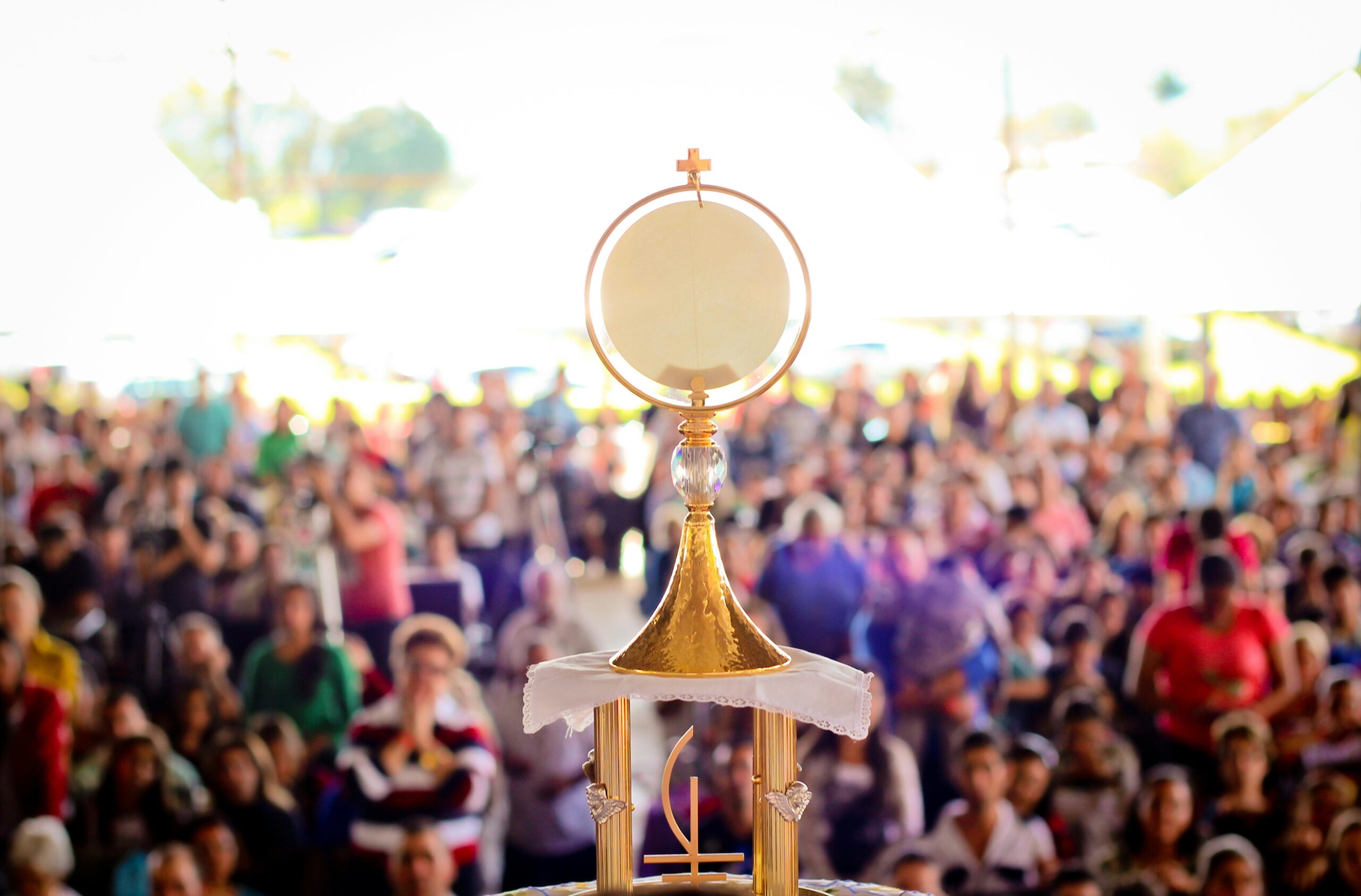In June 2022, the United States Conference of Catholic Bishops launched a National Eucharistic Revival. The primary objective of the three-year, multi-million-dollar initiative is a restoration and renewal of the church’s doctrinal belief in the real presence of Christ the Lord in the sacramental elements of the Eucharist. The video banner atop the Revival’s homepage announces the promising benefits of restored understanding of and renewed devotion to the Blessed Sacrament: joy, hope, healing, unity and meaning.
But how can such promises of hope and unity, even joy and healing, sound to LGBTQ Catholics, and those who love them, when so many members of that community have not felt particularly welcome to the eucharistic table? Might there be promise in the Revival’s focus on devotion of the Blessed Sacrament?
The Revival’s pivot from its second into its third and final year is the National Eucharistic Congress, during which clergy, laity and religious are expected to fill an Indianapolis stadium this July for the climax of the entire project. Leading into the Congress was a nationwide eucharistic pilgrimage comprising on-foot processions from the four ends of the nation. In each, young adults, whether for the entire hundreds of miles or just some portion, walked behind a cleric carrying a gold monstrance displaying a consecrated host.
But how can such promises of hope and unity, even joy and healing, sound to LGBTQ Catholics and those who love them?
The ritual intensifies the Revival’s purpose of nurturing individuals’ practice of adoring the Christ present in the Blessed Sacrament (reserved continuously in the tabernacle of every Catholic church and most chapels). The devotion affords a personal encounter with God’s love, an experience of self in divine presence the Revival homepage describes in four terms: created, fallen, saved, restored.
The current eucharistic processions are a revival of a religious practice that spread across Western Europe in the High Middle Ages, especially as the annual feast of Corpus Christi (the body of Christ) came to proliferate in the 13th century. Today, within the reform and renewal of the entire rites of the Roman Catholic Church mandated by the Second Vatican Council, eucharistic processions are situated within the rites for holy Communion and Worship of the Eucharist Outside Mass.
The rites for Holy Communion Outside Mass continue traditions reaching back to early Christianity, whereby deacons or others would bring some of the consecrated bread from the community’s Sunday celebration to those unable to attend due to sickness or old age.
Reserving some of the consecrated elements in the church throughout the week was for the celebration of Viaticum, the special rite of holy Communion for an actively dying Christian. Now, as back then, Viaticum is the special presence of the Lord accompanying a person from the table of the church’s eucharistic celebration, or Mass, toward the heavenly banquet each celebration anticipates.
The other forms of worship outside of Mass—eucharistic exposition and benediction, eucharistic processions and eucharistic congresses—likewise have as their source the full realization of the Eucharist, namely, the communal celebration of word and sacrament in the Mass.
The current eucharistic processions are a revival of a religious practice that spread across Western Europe in the High Middle Ages.
The instruction for all these rites, which contain within them the practice of adoring Christ fully present in the sacred elements, share the common goal of nurturing believers’ depth of desire and devotion for joining in the celebration of Mass. The rites’ official instructions repeatedly emphasize their origin and goal as the communal celebration of the eucharistic sacrifice, in which Christ is present in the assembled people, the presiding minister, the proclamation of the word and climatically, in the eucharistic elements.
Today’s order of Mass continues the medieval gestures of the priest elevating the host (bread) and chalice (wine) at the point of their consecration in the eucharistic prayer, pausing for his and the assembly’s adoration. The contemporary reformed rite, moreover, has renewed the ancient practice of the faithful regularly sharing in holy Communion, processing together with devotion and adoration as they receive the body and blood of Christ.
Scripture and tradition teach that the ultimate reality, and thus purpose, of holy Communion is the strengthened bond of charity and unity the Lord intended for his disciples, as he taught and commanded at the Last Supper: “My Father is glorified by this, that you bear much fruit … love one another as I have loved you” (Jn. 15:8,12).
But this is the point on which so much pain is experienced by the LGBTQ faithful, who widely experience alienation and even rejection in local assemblies of the body of Christ in their eucharistic celebrations and community life.
The rejection is a contemporary example of what the word of God reveals to have been a sinful affliction in the body of Christ among the very first generation of believers: members of the body of Christ, the church, assembling for the Lord’s supper with disregard or even contempt for the poorer members. (In this case, they are slaves and day laborers, but across the New Testament, the socially deprived include widows and orphans, the ill, disfigured, handicapped, ethnically “other,” etc.)
In the light of the Christ who suffered in love for everyone, all must work for the dignity of each member.
St. Paul reprimands these divisions among the church members in Corinth (1 Cor. 11:18). He then teaches them the true meaning of what the Lord Jesus instituted on the night of his betrayal, the gift of himself, his body and blood “for you” (v. 24). Each sharing in that bread and cup is a proclamation of “the Lord’s death until he comes” (v. 26), that is, his love in service, his suffering unto death for all.
To “eat and drink without discerning the body” (v. 29), without examining their callous, prejudicial behavior, is to “eat and drink judgment against themselves” (v. 31). “For,” Paul admonishes, “in the one Spirit we were all baptized into one body” (12:13).
The Spirit’s instruction in First Corinthians is for every local church, both together and in each member, to examine themselves as to whether and how they are honoring the many diverse members of the body of Christ, giving special care for those considered “less respectable” (12:24). In the light of the Christ who suffered in love for everyone, all must work for the dignity of each member, with special care for those deprived thereof. It is a work to be done, at times prophetically, with and for others.
Yet, for those suffering the brunt of marginalization, it is also a work of self-care in the presence of God. The irreducible sources of strength for the baptized are the word of God and the sacraments, especially the Eucharist. But how can that strengthening, that consolation, that mercy, that empowerment happen when one experiences alienation or even rejection from the members of the body assembled in the eucharistic celebration?
Here, the reformed and renewed forms of eucharistic worship outside Mass, steeped in sound tradition, afford a salvific supplement to the primary celebration. The instruction introducing this type of eucharistic worship emphasizes its origin and goal to be sacramental and ecclesial communion in the Mass.
For those suffering the brunt of marginalization, it is also a work of self-care in the presence of God.
One can nonetheless discern that, for those experiencing alienation or, worse yet, rejection by members or even leaders in the eucharistic celebration, adoration of Christ present in the Blessed Sacrament can be a consoling, strengthening, even healing practice. In this regard, the instruction for this form of worship is worth quoting at length:
[T]he devotion prompting the faithful to visit the blessed sacrament draws them into an ever deeper share in the paschal mystery and leads them to respond gratefully to the gift of him who through his humanity constantly pours divine life into members of his Body.
Abiding with Christ the Lord, they enjoy his intimate friendship and pour out their hearts before him for themselves and for those dear to them and they pray for the peace and salvation of the world. Offering their entire lives with Christ to the Father in the Holy Spirit, they derive from this sublime colloquy an increase of faith, hope, and charity. Thus they foster those right dispositions that enable them with due devotion to celebrate the memorial of the Lord and receive frequently the bread given us by the Father.
Worship of the Eucharist Outside Mass, no. 80.
The imagery of abiding and intimate friendship comes right from Jesus’ words to the disciples at the Last Supper: “As the Father has loved me, so I have loved you; abide in my love. … You did not choose me, but I chose you” (Jn. 15:9,16). In that passage he teaches us that we abide in him “if my words abide in you” (v. 7). This happens through the gift of the Spirit he promised at that supper, and so, the church teaches that one of the modes of Christ’s presence in the eucharistic celebration (Mass) is the proclamation of the word (sacred Scripture).
We must continuously draw from the breadth of the Scriptures to ensure that we are worshiping in spirit and truth (Jn. 4:23), that we are abiding in him and not in a god of our own or anybody’s making. Not surprisingly, then, the instruction for adoration of the Blessed Sacrament likewise encourages reading the word of God in conjunction with silent prayer and reflection. A pocket-size edition of the New Testament and psalms, for example, serves well this purpose.
The lengthy instruction on adoration quoted above immediately adds: “Therefore, the faithful should strive to worship Christ the Lord in the blessed sacrament in a manner fitting in with their own way of life” (no. 80). For many LGBTQ believers, adoring Christ in the Blessed Sacrament, resting back upon him as did the disciple whom Jesus loved (Jn. 13:25), may well be the way the healing and strength the communal celebration of the Eucharist should give.
The word of God, living and active in Scripture and present in the Blessed Sacrament, comprises a bottomless source for joy, hope, healing and meaning.
Still, it is conditioned on our letting Christ’s words abide in us (vs. 15:7), learning and keeping his commandments and thereby loving one another (vs. 10,17). Knowing oneself loved by God, abiding in that love revealed through word and sacrament, with prayerful reflection on one’s life-experience, is the source of loving others. The word of God, living and active in Scripture and present in the Blessed Sacrament, comprises a bottomless source for joy, hope, healing and meaning.
Just as the reservation and ministry of the Eucharist outside the Sunday celebration had its origins (and continues) in service to marginal members of Christ’s body—the sick, the housebound, the dying—so renewed practice of adoring the Lord in the reserved sacrament can minister to members suffering hurt and alienation from members of the body, the church.
Drawing strength from the living word, praying and reflecting before the reserved sacramental presence of the Lord who chose them, Christ’s marginalized friends may experience divine love in their humanity, strengthened faith, renewed hope, indiscriminate charity toward others, and if needed, courage in taking their rightful place in the eucharistic assembly of the church.




